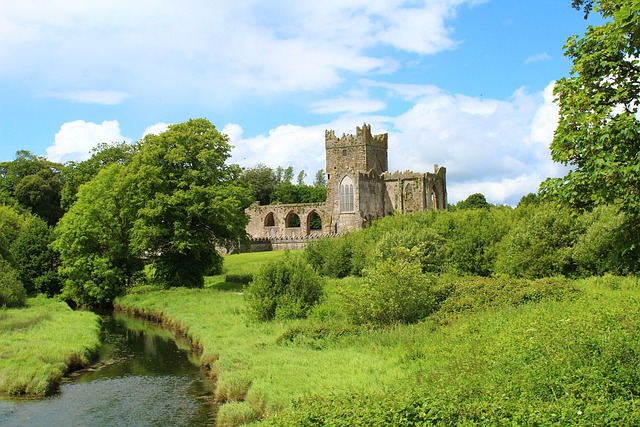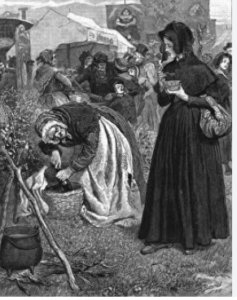Tintern Abbey Summary & Analysis
The poem’s complete title is “Lines Composed a Few Miles above Tintern Abbey, on Revisiting the Banks of the Wye during a Tour. July 13, 1798.” It begins with the speaker noting a five-year gap since his last visit to this location, reflecting on their effect upon him: the “steep and lofty cliffs” impress upon him “thoughts of more deep seclusion”; he leans against the dark sycamore tree and looks at the cottage-grounds and the orchard trees, whose fruit is still unripe. He sees the “wreaths of smoke” rising up from cottage chimneys between the trees. This smoke sparks the speaker’s imagination about the dwellers in the houseless woods or a hermit’s cave.

The speaker then reflects on how memories of these “beauteous forms” influenced him during times of solitude or in bustling towns, providing him with “sensations sweet, / Felt in the blood, and felt along the heart.”. The memory of the woods and cottages offered “tranquil restoration” to his mind. The recollection subtly affected the speaker’s actions, fostering kindness and love.
The memory, even when not consciously present, granted access to a mental and spiritual state where the worldly burden lightened, and he becomes a “living soul” enabling him to see into “the life of things.” The speaker then says that his belief that the memory of the woods has affected him so strongly may be “vain”—but if it is, he has still turned to the memory often in times of “fretful stir.”
Even now, the memory of his past experiences glides over his present perspective, and he feels bittersweet joy in reviving them. He hopes happily, too, that his present experience will offer many joyful memories for future. The speaker accepts that he is different now from how he was in those long-ago times, when, as a boy, he “bounded o’er the mountains” and through the streams. In those days, nature was his entire world: mountains, waterfalls, and woods shaped his passions, his love, and his appetites. That time is now past, he says, but he is not sad for it, for although he cannot recommence his old relationship with nature, he has been adequately repaid by more mature gifts.
He can now “look on nature, not as in the hour / Of thoughtless youth; but hearing oftentimes / The still, sad music of humanity.” And he is now conscious of the presence of something far more powerful, subtle, and fundamental in the light of the setting suns, the ocean, the air itself, and even in the mind of man. He looks at this energy as “a motion and a spirit that impels / All thinking thoughts…. / And rolls through all things.” Due to this reason, he still loves nature, still loves mountains and pastures and woods, for they harbour his purest thoughts and guard the heart and soul of his “moral being.”
The speaker says that even if he did not feel this way or understand these things, he would still have good and high spirits on this day, for he is in the company of his “dear, dear Sister,” who is also his “dear, dear Friend,” and in whose voice and manner he observes his former younger self, and sees “what I was once.” He offers a prayer to nature which he intends to continue knowing, that “Nature never did betray / The heart that loved her,” but leads rather “from joy to joy.” Nature’s power over its seeker’s mind is such that it renders that mind invulnerable to “evil tongues,” “rash judgments,” and “the sneers of selfish men”.
Instead, it instills a “cheerful faith” that the world is full of blessings. The speaker then appeals the moon to shine upon his sister, and the wind to blow against her. He further says to her that if she ever feels sad or fearful in future, she can take help from the recollection of this experience to heal herself. Likewise, he tells her that if he himself is dead, she can recall the love with which he adored nature. She will remember what the woods meant to the speaker, the way in which, after so many years of absence, they became more dear to him—both for themselves and for the fact that she is in them.
Form
In terms of its form, Tintern Abbey is written in blank verse, characterized by unrhymed lines in iambic pentameter. This style lends a fluid and natural quality to the poem, making it as readable as prose. However, the poem’s structure is meticulously constructed; Wordsworth’s subtle deviations from the iambic rhythm are noteworthy. Lines like “Here, under this dark sycamore, and view” don’t precisely adhere to the stress patterns of the meter but loosely fit within it, allowing Wordsworth to approximate the cadences of everyday speech without significantly disrupting the meter. At times, divided lines serve as indicators of paragraph breaks, signaling shifts in subject or focus within the poet’s discourse.
Analysis
The central theme of “Tintern Abbey” revolves around memory, particularly childhood memories of experiencing natural beauty. This theme holds significant importance throughout Wordsworth’s body of work, recurring in poems such as the “Intimations of Immortality” ode. “Tintern Abbey” serves as a foundational declaration of Wordsworth’s primary theme: the idea that memories of a pure connection with nature during childhood continue to influence the mind in adulthood, even after losing direct access to that connection.
Moreover, adulthood brings a maturity of mind that compensates for this loss, granting the ability to perceive nature in relation to human life, to appreciate its significance. In his youth, the poet experienced a thoughtless unity with nature; now, five years since his last encounter with the scene, he is more keenly aware of its offerings. Additionally, the presence of his sister allows him to glimpse his past self. He anticipates that their present experience will yield future memories, akin to the memories that surface during his current journey through the woods.
“Tintern Abbey” unfolds as a monologue, with a solitary speaker conversing with himself, occasionally addressing specific objects within the imagined scene or his sister. The language of the poem is notable for its simplicity and sincerity; the young poet eschews embellishment in favor of heartfelt expression. Imagery predominantly centers on the natural world, though occasional metaphors, such as likening memory to an anchor or the mind to a mansion, offer depth.
Furthermore, the poem subtly carries religious undertones; while the physical structure of the Abbey is absent, the concept of a consecrated place suffuses the scene, as if the forest and fields serve as the speaker’s sanctuary. This notion is reinforced by the speaker’s reverence for the setting sun and the human mind, linking the ideas of God, nature, and the human psyche—a theme recurrent in Wordsworth’s subsequent works, from “It is a beauteous evening, calm and free” to the culmination in the Immortality Ode.
#Tintern Abbey Summary & Analysis #Tintern Abbey Summary & Analysis #Tintern Abbey Summary & Analysis #Tintern Abbey Summary & Analysis #Tintern Abbey Summary & Analysis #Tintern Abbey Summary & Analysis #Tintern Abbey Summary & Analysis #Tintern Abbey Summary & Analysis #Tintern Abbey Summary & Analysis #Tintern Abbey Summary & Analysis #Tintern Abbey Summary & Analysis #Tintern Abbey Summary & Analysis
Read More
Wordsworth and His Love for Nature
Introduction to Fiction and Non Fiction
Of Death — Francis Bacon (Text)
Of Truth Critical Analysis by Sir Francis Bacon
Of Truth by Francis Bacon Summary
Visit Us on our Facebook Page:





Excellent n thought provoking. My concepts are clear now.